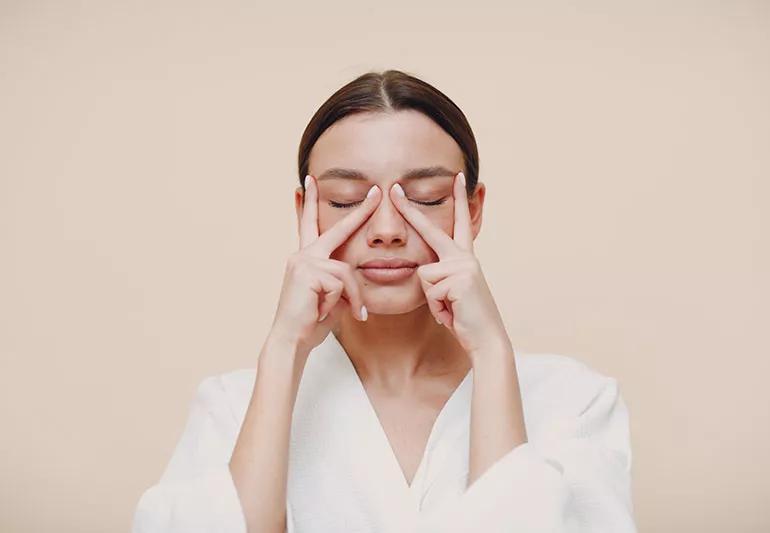A dedicated routine may help, like this 8-step facial massage

We know that getting the blood flowing through regular exercise is good for our bodies. But have you ever heard of doing a workout for your face? It’s an idea that’s gaining traction among people looking to ward off (or reverse) those stubborn crow’s feet.
Advertisement
Cleveland Clinic is a non-profit academic medical center. Advertising on our site helps support our mission. We do not endorse non-Cleveland Clinic products or services. Policy
Some people call it face exercise. Some call it face yoga. And some are calling it into question.
We talked with dermatologist Shilpi Khetarpal, MD, and massage therapist Vickie Bodner, LMT, to better understand what moving your face can do for you.
Recently, researchers took a look at whether people could use targeted exercises to tone their facial muscles and look younger. The results are in, but they’re not so definitive.
The study tasked a small group of women aged 40 and older to devote time every day to a series of facial workouts. The exercises were intended to reduce wrinkles, help fill in hollow cheeks and minimize other signs of aging. These exercises focused on strengthening and building up underlying muscle in the cheeks, jawline, neck, eyelids and eyebrows.
According to the study, participants appeared about three years younger at the program’s end.
Awesome! Sign me up for some face yoga, right? Well … it may not be so simple.
“This study was the first to look at facial exercises and the appearance of aging,” says Dr. Khetarpal. “In considering the results, keep in mind that it’s a small group of highly motivated participants who were willing to do 30 minutes facial exercises daily.”
Advertisement
Wait, 30 minutes devoted to moving your face? Every day? That’s a tall order.
“Unless someone is highly motivated, it’s hard to sustain these facial exercises over a long period of time and achieve these results,” Dr. Khetarpal notes.
She adds that more and bigger studies are needed before dermatologists can recommend facial exercises as a viable anti-aging remedy. Future studies need to include a much larger pool of participants and a control group, as well as longer-term studies to address whether the benefits remained after participants give up the routine.
For those who don’t have the time to dedicate to a daily face exercise routine (especially when it’s not a proven win), even a quick face massage can have some solid benefits. While giving yourself a gentle face massage here and there may not magically erase your laugh lines, it can give your skin a healthy boost, Bodner says.
“Anytime you bring blood flow into an area, it gets your capillaries (blood vessels) moving, which can promote a relaxation of the muscles and get fluids moving,” she explains. “Sometimes, people get puffy under the eyes or in the sinus area. Practicing self-massage on the face may help you release unwanted fluids.”
Massaging your face can also:
Plus, let’s be real, a massage just feels sooo nice sometimes, and releasing tension looks great on just about everyone.
Before performing your own face massage, wash your hands and face. You can use lotion or oil if you choose, but it’s not necessary if you don’t have any handy.
“This will help stimulate your lymphatic system to possibly allow for the drainage of toxins,” Bodner says. “The lymphatic system is close to the skin. You don’t need to press hard. Light pressure will be enough to get things moving.”
One note of caution: Face massage isn’t recommended if you have redness, open sores or bruising on your face. Talk with a healthcare provider if you’re unsure if facial massage is right for you.
Face massage can be done anywhere at any time. Dedicate as much time as you’d like, either performing the following steps as a series or on their own if you’re crunched for time. For optimal relaxation and rejuvenation, complete each exercise up to three times before moving on to the next.
Advertisement
Advertisement
Face massage can give you a quick boost, but if you’re looking for long-term wrinkle prevention, Dr. Khetarpal says there are several evidence-based options. Talk with your healthcare provider about:
Advertisement
Learn more about our editorial process.
Advertisement

Strengthening your skin barrier, simple routines and minimizing products are ongoing, popular trends

Moisturizing, running a humidifier and adjusting your showers may help keep itchiness and irritation at bay

Glycolic acid benefits skin tone, texture and pigmentation by exfoliating dead skin

Some gentle soap and warm water go a long way when you’re washing these cosmetic tools regularly

New formulas are less drying and contain water-based and skin-loving ingredients

At a minimum, in the morning, apply a cleanser, followed by a moisturizer and sunscreen, in that order

The convenient option is good for touch-ups, but it shouldn’t replace your traditional sunscreen

Olive oil works as a skin moisturizer, but it’s not right for everyone

Start having sex about 72 hours before ovulation, then at least every other day during your fertile window

Attachment theory suggests that your earliest relationships shape connections throughout your life

It isn’t a recognized mental health disorder, but research shows that problematic social media use can negatively affect your mental health, self-esteem and sleep